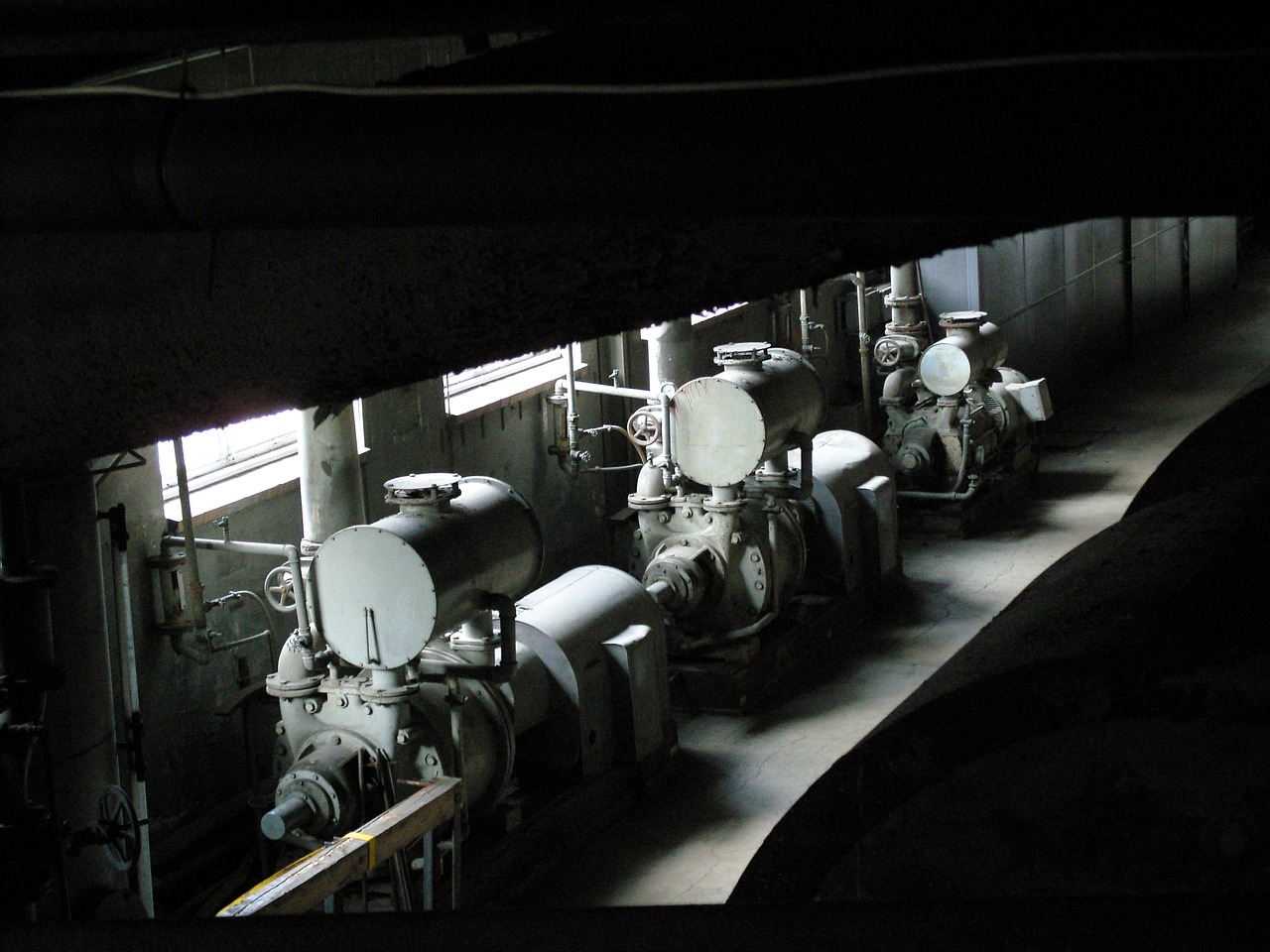How to Conduct Technical Analysis for Cryptocurrencies
In the ever-evolving world of cryptocurrencies, understanding how to conduct technical analysis is crucial for anyone looking to navigate the volatile market effectively. This article delves into the essential techniques and tools for analyzing cryptocurrency markets, helping investors make informed decisions based on price trends, patterns, and indicators. As the crypto landscape continues to grow, mastering these skills can be the difference between making a fortune and facing significant losses. So, buckle up as we explore the fascinating realm of technical analysis!
Technical analysis involves evaluating price movements and trading volumes to predict future market behavior. Unlike fundamental analysis, which focuses on the intrinsic value of an asset based on external factors like news and events, technical analysis is all about the numbers. It’s like being a detective, piecing together clues from past price data to forecast future movements. This approach is particularly important in the cryptocurrency market, where prices can swing wildly in a matter of hours, making it essential for traders to rely on data-driven insights.
To conduct effective technical analysis, traders utilize various tools that help them interpret market data. These tools include charting software and a range of indicators that provide insights into price trends and market sentiment. Some of the most popular tools include:
- Charting Software: Platforms like TradingView and Coinigy allow traders to visualize price movements and apply various technical indicators.
- Technical Indicators: These are mathematical calculations based on price and volume, which help traders make sense of market conditions.
Understanding how to effectively utilize these tools can significantly enhance your trading strategy and decision-making process.
Charts are vital in visualizing price movements over time. They provide a graphical representation of how an asset has performed, making it easier to spot trends and patterns. There are different types of charts, each serving a distinct purpose:
Line charts provide a simple representation of price movement over time, connecting closing prices with a continuous line. They are particularly useful for identifying overall trends in the market. To read a line chart, look for the direction of the line: an upward trend indicates increasing prices, while a downward trend suggests falling prices. It's like following a path through a forest—if the path goes uphill, you're likely heading towards something valuable!
Candlestick charts offer more detailed information about price action, showing the open, high, low, and close prices for a specific time period. Each candlestick represents a specific timeframe, with the body indicating the price range between the open and close. Analyzing candlestick patterns can provide insights into market sentiment. For instance, a series of bullish candlesticks may indicate strong buying pressure, while bearish candlesticks could signal selling pressure. Understanding these patterns is akin to reading the mood of a crowd—certain formations can hint at what might happen next.
Technical indicators are essential tools in a trader's arsenal. They are mathematical calculations based on price and volume data, helping traders identify trends, reversals, and potential entry or exit points. Here are a couple of key indicators:
- Moving Averages: These smooth out price data to identify trends over a specific period. They help traders determine whether to buy or sell based on historical performance.
- Relative Strength Index (RSI): This momentum oscillator measures the speed and change of price movements, helping traders identify overbought or oversold conditions.
Incorporating these indicators into your trading strategy can provide a more comprehensive view of market dynamics.
Recognizing market trends and patterns is crucial for successful trading. Trends can be categorized as upward, downward, or sideways, and understanding these can aid in making informed decisions. It’s like surfing: if you can spot a good wave (trend), you can ride it for a while before it crashes (reverses).
Market trends can be classified into three main types:
- Upward Trends: Characterized by higher highs and higher lows, indicating a bullish market.
- Downward Trends: Defined by lower highs and lower lows, signaling a bearish market.
- Sideways Trends: Occur when prices move within a horizontal range, indicating market indecision.
Identifying these trends can help traders determine when to enter or exit the market.
Chart patterns, such as head and shoulders or triangles, can signal potential price movements. Recognizing these patterns is vital for traders looking to anticipate market shifts. For example, a head and shoulders pattern often indicates a reversal from an uptrend to a downtrend, while triangles can signal continuation or reversal, depending on the breakout direction. These patterns act like road signs, guiding traders on their journey through the market landscape.
Effective risk management is vital in cryptocurrency trading. It’s not just about making profits; it’s also about protecting your investments. Strategies to minimize losses while maximizing potential gains include setting stop-loss orders and diversifying investments.
Stop-loss orders help protect against significant losses by automatically selling an asset when it reaches a predetermined price. By setting and adjusting stop-loss orders based on technical analysis, traders can safeguard their investments and limit potential downturns. Think of it as a safety net—if you fall, it catches you before you hit the ground!
Diversification reduces risk by spreading investments across different assets. This principle can be applied in cryptocurrency portfolios to mitigate the impact of a single asset's poor performance. By investing in a variety of cryptocurrencies, traders can balance their risk, much like a well-rounded diet that includes various food groups for optimal health.
1. What is technical analysis in cryptocurrency trading?
Technical analysis is the evaluation of price movements and trading volumes to predict future market behavior, primarily through the use of charts and indicators.
2. How do I start with technical analysis?
Begin by familiarizing yourself with different chart types, indicators, and patterns. Use charting software to practice analyzing cryptocurrency price movements.
3. Are there risks involved in technical analysis?
Yes, while technical analysis can enhance trading decisions, it is not foolproof. Market conditions can change rapidly, and relying solely on technical analysis without considering other factors can lead to losses.
4. How important is risk management in trading?
Risk management is crucial in trading as it helps protect your investments and minimizes potential losses. Strategies like stop-loss orders and diversification are essential components of a sound risk management plan.

Understanding Technical Analysis
Technical analysis is a crucial component of trading in the cryptocurrency market. It involves the examination of price movements and trading volumes to forecast future market behavior. Unlike fundamental analysis, which focuses on a cryptocurrency's intrinsic value by examining external factors such as technology, team, and market demand, technical analysis relies purely on historical price data and trading patterns. This makes it particularly valuable in the fast-paced world of cryptocurrencies, where prices can fluctuate wildly in a matter of minutes.
Imagine you're a detective, sifting through clues left behind in the form of price charts and volume spikes. Each chart tells a story, revealing the emotions of traders—fear, greed, excitement, and panic. By understanding these emotional responses, you can better predict how the market might behave in the future. This is where technical analysis shines: it provides a framework for making educated guesses about where prices are headed based on past performance.
One of the key advantages of technical analysis is its ability to identify trends. Trends are essentially the direction in which the market is moving, and they can be categorized into three main types:
- Upward Trends: Characterized by higher highs and higher lows.
- Downward Trends: Defined by lower highs and lower lows.
- Sideways Trends: Occur when prices move within a horizontal range.
Understanding these trends is crucial for traders. For instance, if you identify an upward trend, you might consider buying, anticipating that prices will continue to rise. Conversely, in a downward trend, selling might be the prudent choice to avoid losses. It's like surfing; you want to ride the wave in the right direction, not against it.
Moreover, technical analysis is not just about recognizing trends; it also involves understanding various indicators and patterns that can signal potential price movements. These indicators can help traders make informed decisions about when to enter or exit a position. For example, the Relative Strength Index (RSI) can indicate whether a cryptocurrency is overbought or oversold, providing valuable insights into potential price reversals.
In summary, technical analysis is a powerful tool for cryptocurrency traders. By focusing on price movements and trading volumes, it allows for a more data-driven approach to trading. This method not only helps in identifying trends but also enhances the ability to make educated predictions about future price movements. As you delve deeper into the world of cryptocurrencies, mastering technical analysis will undoubtedly give you a competitive edge.
- What is the primary goal of technical analysis? The main goal is to predict future price movements based on historical data.
- How does technical analysis differ from fundamental analysis? Technical analysis focuses on price and volume data, while fundamental analysis considers external factors affecting a cryptocurrency's value.
- Can technical analysis guarantee profits? While it enhances decision-making, no method can guarantee profits due to the volatile nature of cryptocurrency markets.

Key Tools for Technical Analysis
When it comes to navigating the turbulent waters of cryptocurrency trading, having the right tools is akin to a sailor possessing a sturdy ship and a reliable compass. Technical analysis (TA) is no different; it requires a suite of tools to effectively evaluate price movements and trading volumes. These tools not only help in predicting future market behaviors but also empower traders to make informed decisions. So, what are these essential tools, and how can you leverage them for your trading success?
First and foremost, charting software is a must-have for any serious trader. This software allows users to visualize price movements over time, making it easier to spot trends and patterns. Popular platforms like TradingView and MetaTrader offer a variety of features, including customizable charts, a plethora of technical indicators, and community-driven insights. By utilizing these platforms, traders can craft a tailored trading experience that suits their specific strategies.
Next up are technical indicators, which are mathematical calculations based on price and volume data. These indicators serve as signals that can guide traders in their decision-making process. Some of the most commonly used indicators include:
- Moving Averages (MA): These smooth out price data to identify trends over a specific period.
- Relative Strength Index (RSI): This momentum oscillator measures the speed and change of price movements to identify overbought or oversold conditions.
- Bollinger Bands: These bands help in identifying volatility and potential price reversals.
In addition to these tools, understanding how to interpret charts and graphs is crucial. Different types of charts, such as line, bar, and candlestick charts, provide unique insights into market dynamics. For instance, while line charts offer a straightforward view of price movements over time, candlestick charts provide more detailed information about price action, including opening, closing, high, and low prices. This depth of information is invaluable for traders looking to make quick and informed decisions.
| Chart Type | Description | Best Use |
|---|---|---|
| Line Chart | Simple representation of price movement over time. | Identifying long-term trends. |
| Bar Chart | Displays open, high, low, and close prices for a specific period. | Understanding price volatility. |
| Candlestick Chart | Shows price action with more detail than line or bar charts. | Analyzing market sentiment and potential reversals. |
Finally, keeping an eye on news and social media trends can also provide a significant edge in technical analysis. Cryptocurrency markets are heavily influenced by public sentiment and external events. Platforms like Twitter and Reddit often serve as barometers for market mood, so staying updated can help traders anticipate price movements that charts may not yet reflect.
By utilizing these key tools effectively, traders can enhance their technical analysis skills, leading to more informed trading decisions and potentially greater profits. Remember, in the world of cryptocurrency, knowledge is power, and having the right tools at your disposal can make all the difference.

Charts and Graphs
When it comes to technical analysis in the world of cryptocurrencies, charts and graphs are your best friends. They serve as visual representations of price movements over time, allowing traders to spot trends and make informed decisions. Think of charts as the roadmaps of the crypto market; they guide you through the twists and turns of price fluctuations, helping you navigate your trading journey.
There are several types of charts that traders use to analyze cryptocurrency prices, each offering unique insights. The most common types include line charts, bar charts, and candlestick charts. Each of these charts has its own strengths and applications, making them essential tools in your trading arsenal.
Line charts are perhaps the simplest form of charting. They plot the closing prices of a cryptocurrency over a specified time period, connecting these points with a continuous line. This makes it easy to visualize the overall price trend. However, while line charts provide a clear view of price direction, they often lack the detailed information needed for more in-depth analysis.
On the other hand, candlestick charts offer a more comprehensive view of price action. Each 'candlestick' represents a specific time period and displays four critical price points: the open, close, high, and low. This allows traders to gauge market sentiment and volatility at a glance. For instance, a long green candlestick indicates strong buying pressure, while a long red candlestick suggests selling pressure. By analyzing these patterns, traders can make predictions about future price movements.
Here's a quick comparison of the different chart types:
| Chart Type | Description | Best For |
|---|---|---|
| Line Chart | Shows closing prices over time | Identifying overall trends |
| Candlestick Chart | Displays open, close, high, and low prices | Understanding market sentiment and volatility |
| Bar Chart | Similar to candlesticks but uses vertical lines | Visualizing price ranges |
As you dive deeper into technical analysis, you'll find that mastering these charts can significantly enhance your trading strategy. Being able to interpret what the charts are telling you is like having a sixth sense in the trading world. So, whether you prefer the simplicity of line charts or the depth of candlestick charts, incorporating these tools into your analysis will undoubtedly sharpen your trading skills.
In summary, charts and graphs are indispensable in the realm of cryptocurrency trading. They not only help you visualize price movements but also provide critical insights into market trends and potential trading opportunities. As you become more familiar with these tools, you'll find yourself making better-informed decisions, ultimately leading to greater success in your trading endeavors.

Line Charts
Line charts are one of the most straightforward and effective tools for visualizing price movements in the cryptocurrency market. They provide a clear, simple representation of how the price of a cryptocurrency has changed over time, allowing traders to quickly grasp the overall trend without getting bogged down in excessive detail. Think of a line chart as a road map; it shows you where you've been and gives you an idea of where you might be headed. By connecting the closing prices of a cryptocurrency over a specific period, line charts help investors identify trends and make informed decisions.
To read a line chart effectively, you need to understand its components. The horizontal axis (x-axis) typically represents time, while the vertical axis (y-axis) shows the price of the cryptocurrency. Each point on the line represents the closing price at a specific time. As you follow the line, you can quickly see whether the price is trending upwards, downwards, or remaining stable. For example, if you notice a consistent upward slope, it suggests a bullish trend, indicating that the market is generally optimistic about that cryptocurrency. Conversely, a downward slope might indicate bearish sentiment, suggesting that prices are likely to drop further.
While line charts are great for providing a quick overview, they do have some limitations. They only display closing prices, which means that you miss out on important intraday price movements. This is where other types of charts, like candlestick charts, come into play. However, line charts can be incredibly useful for long-term analysis and for spotting major trends. Many traders use them in conjunction with other chart types to get a more comprehensive view of the market.
In addition to analyzing trends, line charts can help traders identify potential support and resistance levels. Support levels are price points where a cryptocurrency tends to stop falling and may bounce back up, while resistance levels are where the price tends to stop rising and may fall back down. By observing how the line interacts with these levels, traders can make educated guesses about future price movements. For instance, if a price repeatedly bounces off a certain level, that level can be considered a strong support. This can be crucial information when making buying or selling decisions.
In summary, line charts are an essential tool in the arsenal of any cryptocurrency trader. They provide a clear and concise way to view price movements over time, helping traders to identify trends, support, and resistance levels effectively. While they may not provide all the details, their simplicity makes them an excellent starting point for anyone looking to dive into technical analysis.

Candlestick Charts
Candlestick charts are a powerful tool in the arsenal of any cryptocurrency trader. They offer a visual representation of price movements that not only shows the open, close, high, and low prices for a specific time period but also provides insights into market sentiment. Imagine trying to read a book without pictures. It would be a lot harder to grasp the story, right? That’s what traditional line charts can feel like compared to candlestick charts. Each "candlestick" represents a specific time frame—be it a minute, an hour, or a day—and contains a wealth of information.
Each candlestick consists of a body and wicks (or shadows) that extend above and below the body. The body represents the range between the opening and closing prices, while the wicks indicate the highest and lowest prices during that period. If the closing price is higher than the opening price, the candlestick is typically colored green or white, signaling bullish sentiment. Conversely, if the closing price is lower, it is often colored red or black, indicating bearish sentiment. This duality makes candlestick charts an excellent way to gauge market psychology at a glance.
To effectively utilize candlestick charts, traders often look for specific patterns that can hint at future price movements. Some of the most common patterns include:
- Doji: Indicates indecision in the market, where the opening and closing prices are virtually the same.
- Hammer: Suggests a potential reversal after a downtrend, characterized by a small body and a long lower wick.
- Engulfing Pattern: Occurs when a small candle is followed by a larger candle that completely engulfs it, indicating a potential reversal.
- Morning Star: A bullish reversal pattern that consists of three candles: a long bearish candle, a short indecisive candle, and a long bullish candle.
Understanding these patterns can significantly enhance your ability to predict market trends. However, it's essential to combine candlestick analysis with other indicators and tools to confirm your observations. For instance, using candlestick patterns in conjunction with moving averages or volume indicators can provide a more comprehensive view of market conditions.
In summary, candlestick charts are not just a pretty face in the world of cryptocurrency trading; they are a vital tool that can help you decode market movements and make informed decisions. By mastering the art of reading these charts, you can gain a significant edge in your trading strategy, turning the chaotic world of crypto into a more navigable landscape.
Q: What is the primary advantage of using candlestick charts over line charts?
A: The primary advantage is that candlestick charts provide more information at a glance, including market sentiment and potential reversal patterns, which line charts do not offer.
Q: How can I learn to read candlestick patterns effectively?
A: Practice is key! Start by studying different patterns and using demo trading accounts to apply your knowledge without risking real money. There are also numerous online resources and courses available.
Q: Can I rely solely on candlestick charts for trading decisions?
A: While candlestick charts are powerful, they should not be your only tool. It's best to combine them with other technical indicators and fundamental analysis to make well-rounded trading decisions.

Technical Indicators
When it comes to trading cryptocurrencies, are your best friends. They provide traders with valuable insights into market behavior, helping to predict potential price movements based on historical data. Think of them as the compass guiding you through the often turbulent waters of crypto trading. Without them, you might feel like you're sailing blind, relying solely on gut feelings rather than solid data. So, let's dive into some of the most important indicators that can enhance your trading strategy.
One of the most widely used technical indicators is the Moving Average (MA). This tool smooths out price data by creating a constantly updated average price. It helps traders identify the direction of the trend over a specific period. For instance, a 50-day moving average can provide insights into the medium-term trend, while a 200-day moving average is often used for long-term analysis. When the price crosses above the moving average, it can be a signal to buy, while crossing below may indicate a sell signal. This simple yet powerful tool can be a game-changer in your trading arsenal.
Another essential indicator is the Relative Strength Index (RSI). This momentum oscillator measures the speed and change of price movements, helping traders identify overbought or oversold conditions in the market. The RSI ranges from 0 to 100, with values above 70 typically indicating that an asset may be overbought, while values below 30 suggest it may be oversold. By understanding the RSI, traders can make more informed decisions about when to enter or exit trades. Imagine it as your temperature gauge for market enthusiasm; too hot might mean it's time to cool off!
To give you a clearer picture, here's a simple comparison of these two indicators:
| Indicator | Purpose | Usage |
|---|---|---|
| Moving Average (MA) | Smooths price data to identify trends | Buy when price crosses above, sell when it crosses below |
| Relative Strength Index (RSI) | Measures momentum to identify overbought/oversold conditions | Buy when RSI is below 30, sell when above 70 |
Additionally, traders often use Volume as a technical indicator. Volume measures the number of assets traded during a specific period and can provide insights into the strength of a price movement. For example, if a cryptocurrency's price is rising but the volume is low, it may not be a sustainable trend. Conversely, a price increase accompanied by high volume suggests strong interest and can indicate a reliable upward trend. It's like the applause at a concert; if the crowd is roaring, you know the performance is captivating!
In summary, technical indicators are crucial for any cryptocurrency trader looking to make informed decisions. By understanding and utilizing tools like Moving Averages, RSI, and Volume, you can navigate the complexities of the market with confidence. Remember, the more you practice interpreting these indicators, the better you'll become at spotting trends and making profitable trades. Now, let’s move on to the next critical aspect of trading: identifying trends and patterns!
- What are technical indicators? Technical indicators are statistical calculations based on historical price and volume data used to forecast future price movements.
- How do I choose the right technical indicators? The right indicators depend on your trading strategy. Experiment with different indicators to see which ones align best with your trading style.
- Can I rely solely on technical indicators for trading? While technical indicators are helpful, it's wise to combine them with fundamental analysis and market news for a comprehensive trading strategy.

Identifying Trends and Patterns
Recognizing market trends and patterns is crucial for successful trading in the volatile world of cryptocurrencies. Just like a seasoned sailor reads the winds and tides to navigate the seas, traders must learn to interpret the ebb and flow of market movements. By identifying these trends and patterns, you can make informed decisions that could lead to profitable trades. But how do you spot these elusive trends? Let’s dive in!
Market trends can be categorized into three main types: upward, downward, and sideways. An upward trend, often referred to as a "bull market," is characterized by rising prices and investor optimism. Conversely, a downward trend, or "bear market," indicates falling prices and a generally pessimistic outlook. Sideways trends occur when prices fluctuate within a narrow range, indicating market indecision. Understanding these trends is like having a compass that guides you through the unpredictable waters of cryptocurrency trading.
To identify these trends effectively, traders often rely on visual tools such as charts. For instance, a line chart can provide a clear view of price movements over time, while a candlestick chart offers more detailed insights into price action, including open, high, low, and close prices for specific time frames. Each type of chart serves as a window into the market's behavior, allowing traders to spot potential entry and exit points.
In addition to recognizing trends, spotting common chart patterns can provide valuable clues about future price movements. For example, the head and shoulders pattern is often seen as a signal that a bullish trend is about to reverse into a bearish trend. Similarly, patterns like triangles can indicate periods of consolidation before a breakout occurs. Understanding these patterns is essential for crafting a well-informed trading strategy.
To make it easier to grasp these concepts, here's a quick overview of some common chart patterns and their implications:
| Chart Pattern | Implication |
|---|---|
| Head and Shoulders | Potential trend reversal from bullish to bearish |
| Inverse Head and Shoulders | Potential trend reversal from bearish to bullish |
| Triangles (Ascending, Descending, Symmetrical) | Indicate consolidation; breakout direction can vary |
| Double Top/Bottom | Signifies potential reversal after a strong trend |
As you hone your skills in identifying these trends and patterns, remember that patience is key. Just like a master chef doesn’t rush the cooking process, successful traders take their time to analyze the market carefully before making their next move. By combining your knowledge of trends with sound risk management strategies, you’ll be better equipped to navigate the ever-changing landscape of cryptocurrency trading.
- What is the difference between a trend and a pattern? A trend refers to the general direction of the market (upward, downward, or sideways), while a pattern is a specific formation on a chart that suggests potential future price movements.
- How can I practice identifying trends and patterns? You can practice by analyzing historical price charts and trying to identify trends and patterns without the influence of current market conditions.
- Are there any tools that can help with identifying trends? Yes, many trading platforms offer built-in tools and indicators to help traders identify trends and patterns more easily.

Types of Market Trends
Understanding the is crucial for any cryptocurrency trader aiming to make informed decisions. Trends are the general direction in which the market is moving, and they can be categorized into three main types: upward trends, downward trends, and sideways trends. Each type presents unique opportunities and challenges for traders. So, let's dive into these trends and see how they can impact your trading strategy!
First up, we have the upward trend. This is characterized by a series of higher highs and higher lows, indicating that buyers are in control. Imagine a mountain range where each peak represents a new price high. In an upward trend, the market is generally bullish, and traders often look for opportunities to buy on dips. The key here is to identify these dips, as they can provide excellent entry points. A trader might use tools like moving averages to help confirm that the upward trend is intact.
On the flip side, we have the downward trend. In this scenario, the market is experiencing lower highs and lower lows, which signals that sellers are dominating the market. Picture a descending staircase where each step down represents a new price low. This trend can be intimidating, but savvy traders often look for short-selling opportunities. It’s essential to stay alert during these trends, as they can shift quickly. Utilizing technical indicators, such as the Relative Strength Index (RSI), can help traders gauge whether a cryptocurrency is oversold and might be due for a bounce.
Lastly, there’s the sideways trend, also known as a range-bound market. In this case, prices fluctuate within a relatively stable range, neither making significant upward nor downward movements. Think of it as a calm sea where the waves are gentle and predictable. While this might seem dull, it can actually present unique trading opportunities, especially for day traders who thrive on volatility. Traders often use support and resistance levels to identify potential breakout points when the price eventually decides to move.
To summarize the types of market trends, here’s a quick overview:
| Trend Type | Description | Trading Strategy |
|---|---|---|
| Upward Trend | Characterized by higher highs and higher lows. | Buy on dips; look for bullish signals. |
| Downward Trend | Characterized by lower highs and lower lows. | Look for short-selling opportunities; watch for bearish signals. |
| Sideways Trend | Price moves within a stable range. | Trade within the range; identify breakout points. |
By understanding these trends, you can better position yourself in the cryptocurrency market. Whether you’re riding the waves of an upward trend or navigating the choppy waters of a downward trend, knowing what to look for can make all the difference in your trading success.
Q: How can I identify an upward trend?
A: Look for a series of higher highs and higher lows on your charts. Tools like moving averages can help confirm the trend.
Q: What should I do in a downward trend?
A: Consider short-selling opportunities and keep an eye on technical indicators to gauge market sentiment.
Q: Are sideways trends a good time to trade?
A: Yes! Sideways trends can offer trading opportunities, especially if you can identify support and resistance levels.

Common Chart Patterns
When it comes to cryptocurrency trading, understanding common chart patterns is like having a treasure map in a sea of uncertainty. These patterns can provide invaluable insights into potential price movements, helping traders make informed decisions. Chart patterns are typically categorized into two types: continuation patterns and reversal patterns. Continuation patterns suggest that the current trend will continue, while reversal patterns indicate a potential change in trend direction.
One of the most well-known continuation patterns is the flag pattern. This pattern resembles a flag on a pole and occurs after a strong price movement. Flags typically form when the price consolidates for a short period before continuing in the same direction. Another popular continuation pattern is the pennant pattern, which looks like a small symmetrical triangle. It forms after a significant price movement and often signals that the price is about to break out in the direction of the previous trend.
On the other hand, reversal patterns can signal an impending change in market sentiment. The head and shoulders pattern is a classic example of a reversal pattern. It consists of three peaks: a higher peak (the head) between two lower peaks (the shoulders). This pattern typically indicates that an upward trend is about to reverse into a downward trend. Conversely, the inverse head and shoulders pattern suggests that a downward trend may reverse into an upward trend, making it a bullish signal.
Another common reversal pattern is the double top and double bottom. A double top occurs after an upward trend and is characterized by two peaks at approximately the same price level. This pattern suggests that the price may soon decline. In contrast, a double bottom pattern appears after a downward trend and features two troughs at similar price levels, indicating a potential price increase.
Understanding these patterns can significantly enhance your trading strategy. However, it's essential to remember that no pattern is foolproof. They should be used in conjunction with other technical analysis tools and indicators for better accuracy. For instance, combining chart patterns with volume analysis can provide further confirmation of a potential price movement.
To summarize, here are some key chart patterns to watch for:
- Continuation Patterns:
- Flag Pattern
- Pennant Pattern
- Reversal Patterns:
- Head and Shoulders
- Inverse Head and Shoulders
- Double Top
- Double Bottom
By familiarizing yourself with these common chart patterns, you can navigate the exciting yet volatile world of cryptocurrency trading with more confidence. Remember, the key to successful trading lies not just in recognizing these patterns but also in understanding their implications and using them wisely within your trading strategy.
Q: What are chart patterns in cryptocurrency trading?
A: Chart patterns are formations created by the movement of prices on a chart. They help traders predict potential future price movements based on historical data.
Q: How can I identify chart patterns?
A: Identifying chart patterns requires practice and familiarity with different types of patterns. Use charting tools and software to help visualize patterns in real-time.
Q: Are chart patterns always reliable?
A: While chart patterns can provide insights, they are not always reliable. It's crucial to use them alongside other technical indicators and analysis methods.

Risk Management Strategies
When it comes to cryptocurrency trading, the thrill of potential profits can sometimes overshadow the importance of risk management. However, without a solid risk management strategy, even the most promising trades can lead to significant losses. Think of risk management as your safety net; it’s not just about what you can gain, but also about protecting what you already have. So, how do you effectively manage risk in the wild world of crypto?
One of the most effective strategies is setting stop-loss orders. A stop-loss order is an automatic instruction to sell a cryptocurrency when it reaches a certain price. This is crucial because it helps protect your investment from drastic market downturns. For instance, if you purchase a coin at $100 and set a stop-loss at $90, your losses are capped at 10%. This way, you can trade with a sense of security, knowing that your potential losses are limited.
Another vital strategy is diversifying your investments. Just like a balanced diet is essential for health, diversifying your portfolio is key to reducing risk. By spreading your investments across different cryptocurrencies, you can minimize the impact of a poor-performing asset. For example, if you invest in Bitcoin, Ethereum, and a few altcoins, a drop in one coin's value might not significantly affect your overall portfolio. Here’s a simple table to illustrate how diversification can work:
| Cryptocurrency | Investment Amount | Current Value | Percentage of Portfolio |
|---|---|---|---|
| Bitcoin | $500 | $450 | 45% |
| Ethereum | $300 | $350 | 35% |
| Litecoin | $200 | $150 | 20% |
As you can see, even if Litecoin takes a hit, the gains from Bitcoin and Ethereum can help cushion the blow. Diversification isn’t just a buzzword; it’s a practical approach to managing risk.
Finally, it’s essential to regularly review and adjust your risk management strategies. The cryptocurrency market is notoriously volatile, and what works today might not work tomorrow. Being flexible and adapting your strategies based on market conditions can make a significant difference in your overall success. For instance, if you notice a consistent pattern of losses in a particular investment, it might be time to reevaluate that position.
In summary, effective risk management in cryptocurrency trading involves a combination of setting stop-loss orders, diversifying your investments, and continually reviewing your strategies. By incorporating these approaches, you can navigate the unpredictable waters of the crypto market with greater confidence and security.
- What is a stop-loss order? A stop-loss order is an instruction to sell a cryptocurrency when it reaches a specific price, helping to limit potential losses.
- How can diversification reduce risk? By spreading investments across different assets, diversification minimizes the impact of poor performance in any single cryptocurrency.
- Why is it important to review risk management strategies? The cryptocurrency market is highly volatile, so regularly reviewing strategies ensures they remain effective and relevant to current market conditions.

Setting Stop-Loss Orders
When it comes to trading cryptocurrencies, one of the most critical aspects to consider is risk management. This is where stop-loss orders come into play. A stop-loss order is essentially a safety net, designed to protect your investment from significant losses by automatically selling your assets when they reach a certain price. Imagine you're on a roller coaster, and you have a safety bar that prevents you from falling out—this is what a stop-loss order does for your trading portfolio.
Setting a stop-loss order is not just about placing a number; it involves a strategic approach that takes into account market volatility, your trading style, and your overall investment goals. For instance, if you’re a day trader who thrives on quick price movements, you might set tighter stop-loss levels to lock in profits and minimize losses. On the other hand, if you’re a long-term investor, you might opt for wider stop-loss levels to ride out short-term fluctuations.
Here are some essential considerations when setting your stop-loss orders:
- Market Volatility: Cryptocurrencies are notorious for their price swings. A stop-loss set too close to the current market price might trigger a sell during a minor dip, while a stop-loss set too far might expose you to larger losses.
- Support and Resistance Levels: Identifying key support and resistance levels can help you set your stop-loss orders more effectively. Placing a stop-loss just below a support level can protect you from a breakdown, while setting it above a resistance level can help secure profits.
- Investment Strategy: Your overall trading strategy should dictate your stop-loss placement. If you’re using a trend-following strategy, consider placing your stop-loss below the most recent swing low.
To illustrate this, let’s take a look at a simple table that summarizes different scenarios for setting stop-loss orders based on trading strategies:
| Trading Strategy | Stop-Loss Placement | Considerations |
|---|---|---|
| Day Trading | 1-2% below entry price | Quick trades require tight stop-losses to minimize losses. |
| Swing Trading | 3-5% below recent low | Allows for minor fluctuations while targeting larger price moves. |
| Long-Term Investing | 10% below entry price | Wider stop-loss to accommodate for longer-term price movements. |
In conclusion, setting stop-loss orders is a fundamental component of cryptocurrency trading that can save you from emotional decision-making and significant financial losses. It’s not just about where you set the stop-loss, but also understanding the market dynamics that influence your investment. Remember, the goal is to protect your capital while maximizing your potential for gains. As you refine your trading strategy, be sure to adjust your stop-loss orders accordingly to align with your evolving market insights.
Q: What is a stop-loss order?
A: A stop-loss order is an instruction to sell a cryptocurrency when its price falls to a certain level, helping to minimize potential losses.
Q: Can I change my stop-loss order?
A: Yes, you can adjust your stop-loss order at any time based on market conditions and your trading strategy.
Q: What happens if the market price drops below my stop-loss order?
A: If the market price drops below your stop-loss level, the order will trigger a sale at the next available price, which may be lower than your stop-loss price in a fast-moving market.
Q: Is it advisable to use stop-loss orders for all trades?
A: While stop-loss orders can be beneficial, they should be used judiciously based on your trading style and market conditions.

Diversifying Investments
Diversification is not just a fancy term thrown around in finance; it’s a strategy that can make or break your investment portfolio, especially in the volatile world of cryptocurrencies. Imagine you're at a buffet with a myriad of dishes. Would you fill your plate with just one item, risking a bad meal? Of course not! Similarly, spreading your investments across various cryptocurrencies can help mitigate risks and enhance your chances of profitability.
In the crypto market, where prices can swing dramatically within hours, having a diversified portfolio can act as a safety net. By investing in a mix of established coins like Bitcoin and Ethereum, alongside promising altcoins, you can shield yourself from the unpredictability of any single asset. This way, if one asset takes a nosedive, the others can potentially balance out the losses.
Let’s break down the key benefits of diversification:
- Risk Reduction: By investing in different cryptocurrencies, you minimize the impact of a poor-performing asset on your overall portfolio.
- Opportunity for Growth: Diversifying allows you to tap into various market segments. Some coins may perform better than others, and being invested in multiple assets increases your chances of capitalizing on those opportunities.
- Market Volatility Management: The crypto market is notoriously volatile. A diversified portfolio can help smooth out the bumps caused by sudden price fluctuations.
However, it’s crucial to remember that diversification doesn’t mean throwing money at every coin available. It requires a strategic approach. Here are a few tips to effectively diversify your crypto investments:
- Research: Always conduct thorough research on the cryptocurrencies you wish to invest in. Understand their technology, use cases, and market potential.
- Asset Allocation: Decide how much of your total investment you want to allocate to each cryptocurrency. This should be based on your risk tolerance and investment goals.
- Regular Review: The crypto market is dynamic. Regularly review your portfolio and make adjustments as necessary to maintain your desired level of diversification.
In conclusion, diversifying your investments in cryptocurrencies is akin to having a well-rounded diet. Just as you wouldn’t rely solely on one food group for your nutritional needs, you shouldn’t depend on a single cryptocurrency for your investment returns. By spreading your investments wisely, you can enhance your chances of achieving your financial goals while managing risk effectively.
1. What is the best way to diversify my cryptocurrency investments?
To diversify effectively, consider investing in a mix of established cryptocurrencies and promising altcoins. Research their fundamentals and market potential before making any investment decisions.
2. How many different cryptocurrencies should I invest in?
There's no one-size-fits-all answer, but a good rule of thumb is to invest in a range of 5 to 10 different cryptocurrencies to achieve a balanced portfolio while avoiding over-diversification.
3. Can I lose money even if I diversify my investments?
Yes, diversification can help reduce risk, but it doesn’t eliminate it entirely. The crypto market is volatile, and all investments carry some level of risk.
4. How often should I review my cryptocurrency portfolio?
It's advisable to review your portfolio regularly—at least every few months or after significant market movements—to ensure your investments align with your goals and risk tolerance.
Frequently Asked Questions
- What is technical analysis in cryptocurrency trading?
Technical analysis is the process of evaluating price movements and trading volumes to predict future market behavior. Unlike fundamental analysis, which looks at the underlying factors affecting an asset's value, technical analysis focuses solely on price trends and patterns. This approach helps traders make informed decisions based on historical data.
- What are the key tools used for technical analysis?
Some essential tools for conducting technical analysis include charting software and various indicators. Popular tools include line charts, candlestick charts, and technical indicators like Moving Averages and the Relative Strength Index (RSI). Each of these tools plays a vital role in analyzing price movements and identifying potential trading opportunities.
- How do I read candlestick charts?
Candlestick charts provide detailed information about price action over a specific time frame. Each candlestick represents the opening, closing, high, and low prices for that period. By analyzing the patterns formed by these candlesticks, traders can gain insights into market sentiment and potential future price movements.
- What are market trends, and why are they important?
Market trends refer to the general direction in which the price of an asset is moving—upward, downward, or sideways. Recognizing these trends is crucial for successful trading, as they help traders make informed decisions about entry and exit points. Understanding market trends can significantly enhance a trader's ability to capitalize on price movements.
- What are some common chart patterns to look for?
Common chart patterns include head and shoulders, triangles, and flags. These patterns can signal potential price movements and help traders anticipate market behavior. By learning to recognize these patterns, traders can improve their chances of making profitable trades.
- How can I manage risks while trading cryptocurrencies?
Effective risk management is vital in cryptocurrency trading. Strategies include setting stop-loss orders to protect against significant losses and diversifying investments across different assets. By implementing these strategies, traders can minimize their risks while maximizing potential gains, leading to a more balanced trading approach.
- What is a stop-loss order, and how do I set one?
A stop-loss order is a tool that helps protect traders from significant losses by automatically selling an asset when it reaches a certain price. To set a stop-loss order, traders must determine their risk tolerance and choose a price level that reflects their strategy. Adjusting stop-loss orders based on technical analysis can help manage risks effectively.
- Why is diversification important in cryptocurrency trading?
Diversification is a strategy that reduces risk by spreading investments across different assets. In the volatile world of cryptocurrencies, this approach can help protect a trader's portfolio from significant losses. By applying diversification principles, traders can balance their investments and increase their chances of achieving consistent returns.



















